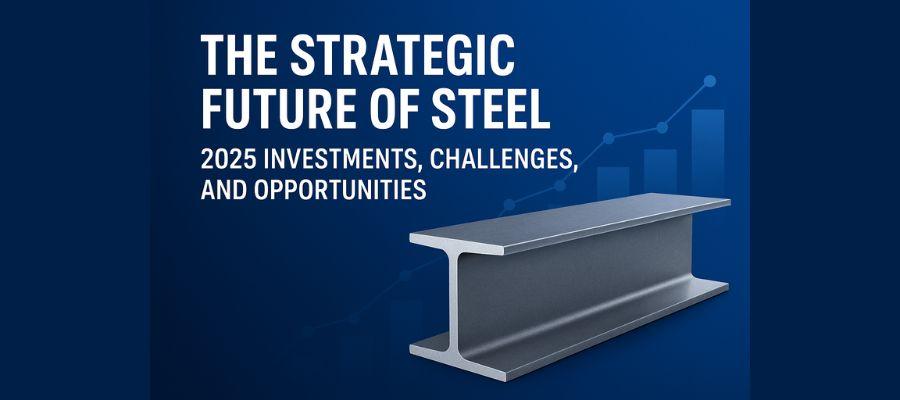The steel industry has always been a cornerstone of global industrial development, powering infrastructure, construction, automotive, energy, and manufacturing sectors. As we move into 2025, the industry finds itself at a turning point. Balancing massive investment needs, mounting challenges, and new opportunities, steelmakers must strategically position themselves to thrive in an era defined by sustainability, innovation, and shifting market demands.
Global Investments Driving Steel Growth
The year 2025 is expected to be a landmark period for steel investment worldwide. Countries are pouring billions into infrastructure and renewable energy projects, all of which rely heavily on steel.
- Infrastructure Boom: Governments in Asia, the Middle East, and Africa are prioritising highways, smart cities, and energy plants, all of which increase the demand for high-quality steel.
- Green Steel Initiatives: Investments are flowing into low-carbon steelmaking technologies, including hydrogen-based reduction and carbon capture systems, particularly in Europe and Japan.
- Digital Transformation: From AI-driven production lines to predictive maintenance, digital investments are enabling steel plants to maximise efficiency, reduce downtime, and improve quality.
These investments are reshaping not just how steel is made, but also how it is consumed across industries.
Key Difficulties Facing the Steel Industry in 2025
Despite the positive momentum, the steel industry continues to grapple with several structural and external challenges:
1. Environmental Pressures
Steel production accounts for nearly 8% of global carbon emissions. With stricter international climate regulations and ESG (Environmental, Social, Governance) expectations, producers must adapt rapidly. The cost of transitioning to greener technologies remains high, creating barriers for smaller and mid-sized companies.
2. Raw Material Volatility
The prices of iron ore, coal, and scrap metal are unpredictable. Any fluctuations directly impact production costs and profitability, making supply chain stability a pressing concern in 2025.
3. Geopolitical Uncertainty
Trade restrictions, tariffs, and geopolitical tensions continue to disrupt global steel flows. The steel industry’s dependence on global trade leaves it vulnerable to sudden market shifts.
4. Technological Transition
While automation and AI offer clear benefits, integrating these technologies requires massive capital and skilled labour. Training workforces and adapting legacy systems remain significant challenges.
5. Competition and Overcapacity
Markets like China and India continue to produce at large scale, leading to overcapacity. This creates downward pricing pressure and intensifies competition globally.
Opportunities on the Horizon
Despite these hurdles, 2025 also presents exciting opportunities that can redefine the future of steel:
1. Green Steel Leadership
Producers who successfully transition to eco-friendly methods will not only meet regulatory requirements but also gain a competitive edge. Global automakers and construction firms are already prioritising low-carbon steel suppliers.
2. Infrastructure and Energy Projects
From wind turbine towers to electric vehicle frames, steel remains indispensable. With global renewable energy capacity expected to double by 2030, steel demand in energy sectors will remain robust.
3. Technological Breakthroughs
AI-driven supply chains, 3D printing of steel components, and IoT-enabled factories present opportunities for smarter, more cost-efficient production. Companies investing early in these technologies will lead the market.
4. Regional Growth
Emerging economies in Africa and Southeast Asia are expected to see rapid steel consumption growth. For global players, this opens avenues for expansion and long-term investment.
Quick Snapshot: Steel in 2025
Category | Key Outlook for 2025 |
Investments | Green steel, digital technologies, infrastructure |
Major Difficulties | Environmental compliance, raw material volatility, overcapacity |
Opportunities | Renewable energy, smart construction, regional growth |
Conclusion
The strategic future of steel in 2025 lies in striking a delicate balance: investing in innovation and sustainability while overcoming long-standing industry challenges. Companies that embrace digitalisation, focus on reducing carbon footprints, and expand into emerging markets will be positioned not just to survive, but to lead in the global steel race.
For investors, governments, and industry leaders alike, 2025 represents both a test of resilience and a chance to reshape steel into a smarter, greener, and more competitive sector for decades to come.
For updates and additional information, follow on social media platforms.
Social Media: LinkedIn, Instagram, Facebook, Pinterest.

